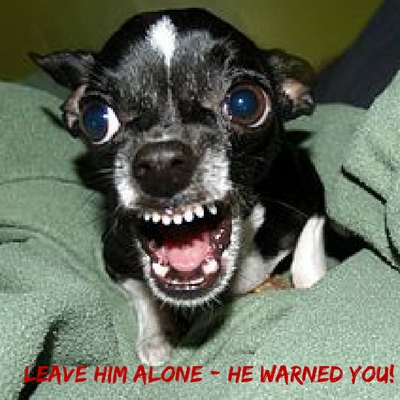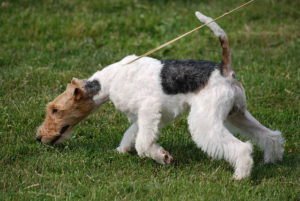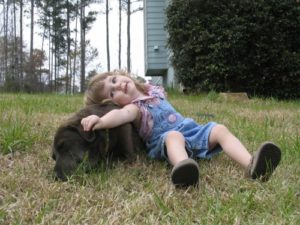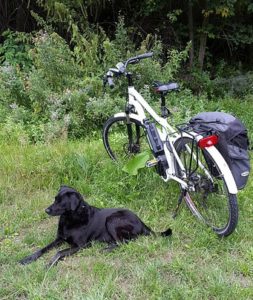
Dog bite prevention is something we need to take seriously, so here are some extremely helpful tips to keep you, and others, safe.
Despite the amount of information available on the proper care and treatment of dogs, many pet guardians still have no clue. They don’t bother training their dogs, then can’t handle the out of control animal they’re left with. That dog is now a  perfect candidate to harm one of them, or a stranger.
perfect candidate to harm one of them, or a stranger.
While the rest of us are preaching responsible pet guardianship, there is a lot parents can do to protect their children and themselves, from dogs living with those who haven’t gotten the message yet.
This information on dog bite prevention not only applies to unfamiliar dogs you encounter in peoples’ homes or on the streets, but to your own dog as well.
For tips relevant to both kids and adults, I am giving the adults the benefit of the doubt, and listing them under the heading for kids. You’ll be reading that section anyway, so you may pick up some information you hadn’t been aware of.
It is fair to assume when people meet an old dog who’s plodding along down the street, they wouldn’t imagine that “oldie” could pose a bite risk. You may disagree with what I am about to say next, but if that dog made it this far, he is probably very well behaved. The flip side is, he could have health issues that are causing him discomfort, and may get annoyed more quickly these days. If you or a child reach out without asking the pet parent, that dog could react, simply because he isn’t feeling well.
Tips to share with your kids
Never run up to a dog you don’t know. The dog may or may not like children, be used to being around them, or have behaviour issues that make it unwise, and a safety issue, to interact with them. Approach slowly and quietly, and ask the owner for permission to pet the dog. If the owner says no, make sure your child understands the owner knows his  dog’s temperament, and is just looking out for the child’s safety. If the owner is not there, stay away.
dog’s temperament, and is just looking out for the child’s safety. If the owner is not there, stay away.
Not every dog likes to be hugged and kissed, so whether it’s your own dog, or one you don’t know, best to avoid putting your face in his, and teach your kids to scratch a dog behind the ears.
Don’t tease a dog, or bother him when he’s eating, sleeping or protecting something – her puppies or even a favourite toy – for example.
If an unknown dog approaches, it may seem like instinct to scream or run away, but that could be very dangerous. Stand still, fold your hands, and look at your shoes, avoiding eye contact. He should lose interest, and eventually leave. When he does, slowly back away.
When meeting a new dog, let the dog come to you. Let him sniff either the back of your hand, or present him with your open hand, palm outwards.
Little kids can be rough with their dogs – pulling ears or tails. Even if the dog seems okay with it, one day your child may pull just a bit too hard, or the dog just becomes fed up, and he may bite. Teach your kids to play nicely.
Tips for adults
Always supervise interaction between your children and dogs. Only once the child has shown they can handle the dog, and the dog respects the child, is it okay to leave them alone.
 Just because a dog is good natured, doesn’t mean he’s used to being around children, and may quickly show another side when around them.
Just because a dog is good natured, doesn’t mean he’s used to being around children, and may quickly show another side when around them.
Teach your children to respect dogs and all animals.
Roughhousing with your dog seems like fun for many, but it’s not a good idea. Rough play can lead to aggression, which can escalate to biting.
If your child does get bitten, seek medical attention right away. Let your child know it wasn’t their fault, and talk about the importance of training and proper treatment of dogs. Don’t let this incident develop into a lifelong fear of them.
Train your dog, but never use methods that call for physical punishment. Involve your entire family, and make sure that training includes getting used to, and enjoying being around children.
Learn to interpret dog body language, and teach your children the signs as well. Dogs will warn before biting.
If your dog seems stressed or anxious, leave him alone.
If you visit a house with a dog, don’t leave your child unsupervised.
Don’t approach an injured dog, if you have no experience. Contact a vet, or animal control for help.
What dog parents can do to prevent their dog becoming a statistic
Spay or neuter your dog. It makes them healthier, calmer, and eliminates the chance of unwanted dogs ending up in  shelters, or in situations where they will be mistreated and become aggressive.
shelters, or in situations where they will be mistreated and become aggressive.
Teach your dog how to live in your world. Dogs should be trained, socialised and exposed to different people, experiences and situations. Get him used to bicycles, strollers, children, the elderly, vacuum cleaners… If you’re not confident doing the training, sign him up for obedience classes, or hire a trainer for private lessons.
Supervise your dog around kids. When kids come over wanting to pet your dog, and there are no parents in sight, why not do what their parents should be doing. Tell them to always ask permission from the dog’s owner, then show them how to pet a dog properly. It is better they learn from someone, than not at all.
- If you notice aggressive tendencies in your dog, warn anyone who approaches, and walk away.
- Always praise your dog for good behaviour.
- If your guests’ kids are bothering your dog, aside from getting the parents to control them, you can put your dog in another room, or explain why they have to leave. Your house, your call!
- Keep up to date on your dog’s vaccinations, including rabies.
- Never use violence or get physical in any way, when disciplining your dog.
- Keep your dog on a leash, until you are confident he listens to your commands.
How to recognise a dog bite situation
There are so many stories in the news, sometimes it feels like daily, about another kid who got bitten by a dog. What they should talk about, in an effort to educate the public (a great opportunity by the way!), is that dogs usually send off signals, before they bite.
How many signs were ignored, before it escalated to the biting stage? That’s because these pet guardians never took the time to train their dog, or understand them.
The most obvious signs are growling and snapping. Others include: hair standing up on their body (hackles raised); licking lips when food is not involved; yawning; turning his head to avoid eye contact; a wagging tail that is pointed high, and moving quickly back and forth.
A fearful dog is one that is cowering, tail tucked between his back legs. He won’t necessarily bite, but the chances are greater if he feels he needs to protect himself.
Dog bite prevention tips – conclusion
I hope this article hasn’t scared anyone away from having a dog or allowing their children to interact with them. It’s just a way to offer suggestions on how to make dog encounters positive ones. Dog bite prevention must be taken more seriously to protect ourselves, those around us, and of course our dogs from being considered dangerous, taken away from us, and ultimately killed.

 Why Dogs Bark
Why Dogs Bark
Hi Hindy
I love your article, as always you give such good advise.
I don’t have a dog (I have a cat as you know) but I always tell my children to ask the dog handler if they can pet their dog. This is not only to protect my children but also the dog because as you say, some dogs don’t like to be petted esp by strangers.
My nephew has a Jack Russel and to be honest I don’t think that he is trained very well and when he snaps at children, they blame the children. I seriously worry that one day the dog will bite someone!! At the end of the day, it will be the dog that will get punished when they really should be trained and handled properly.
Anyway, thanks again for a great and very informative read.
Olive
Thanks Olive. Great advice you’re giving your kids. It makes for positive experiences, and hopefully a lifelong love of animals. As far as your nephew, you’re right. These people blame everyone else, and when the dog bites someone, animal control or the police will take that dog and kill him. I’m sure you’ve already done this, but you might want to strongly recommend they take that dog for training. It isn’t fair on the dog, or pleasant for anyone living in a home with an uncontrollable dog. I hope he gets some help.
Hi Hindy, I haven’t suggested that they take the dog for training but I will do.
Thanks again.
Olive
Good luck Olive! Most people don’t like to get advice when it comes to their pets, but it’s sad for the dog, and probably not much fun for the family. I’m happy to help them if I can. They can use the contact form at the top of the site, if they have any questions or need some tips.
Hi,
I went on a tangent reading dog bite prevention tips this morning and found some of your work at https://caringforaseniordog.com/dog-bite-prevention-extremely-helpful-tips. I agree that kids should know how to act around a dog, after all, kids love to play with a dog. Teasing a dog could be a bad thing, and the owner should be supervising because the kid might not know they are invading the dogs personal space. Knowing that even a good natured dog can bite should be a known fact with the owner, so knowing the dogs body language should prevent problems in the future.
Take care!
Timothy LaClear
Thanks for your comment Timothy and yes you’re right. Children do need to be taught how to act around a dog, and understand dog body language because even the sweetest and gentlest dog can get annoyed enough to bite.
Hi Hindy
I really like your write-up, as generally you give such good advise.
I do not have a dog but I usually tell my youngsters to ask the dog handler if they are able to pet their dog. This really is not simply to shield my youngsters but also the dog since as you say, some dogs don’t like to be petted esp by strangers.
Thank you Paula, and yes that’s very good advice to tell your kids. I wish more parents did that!!